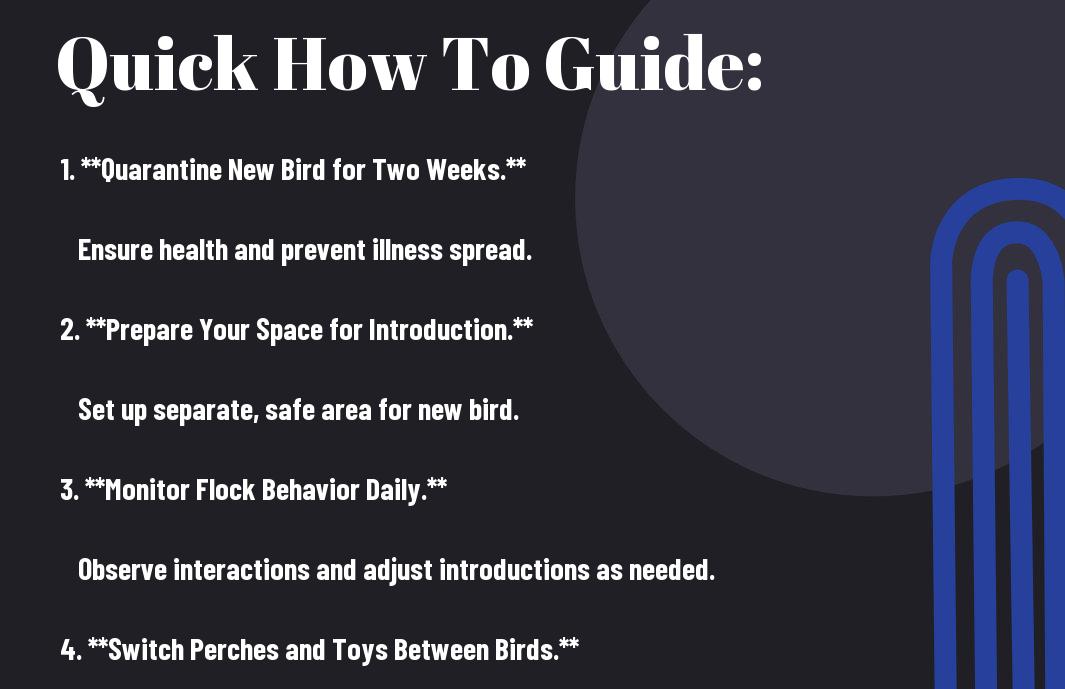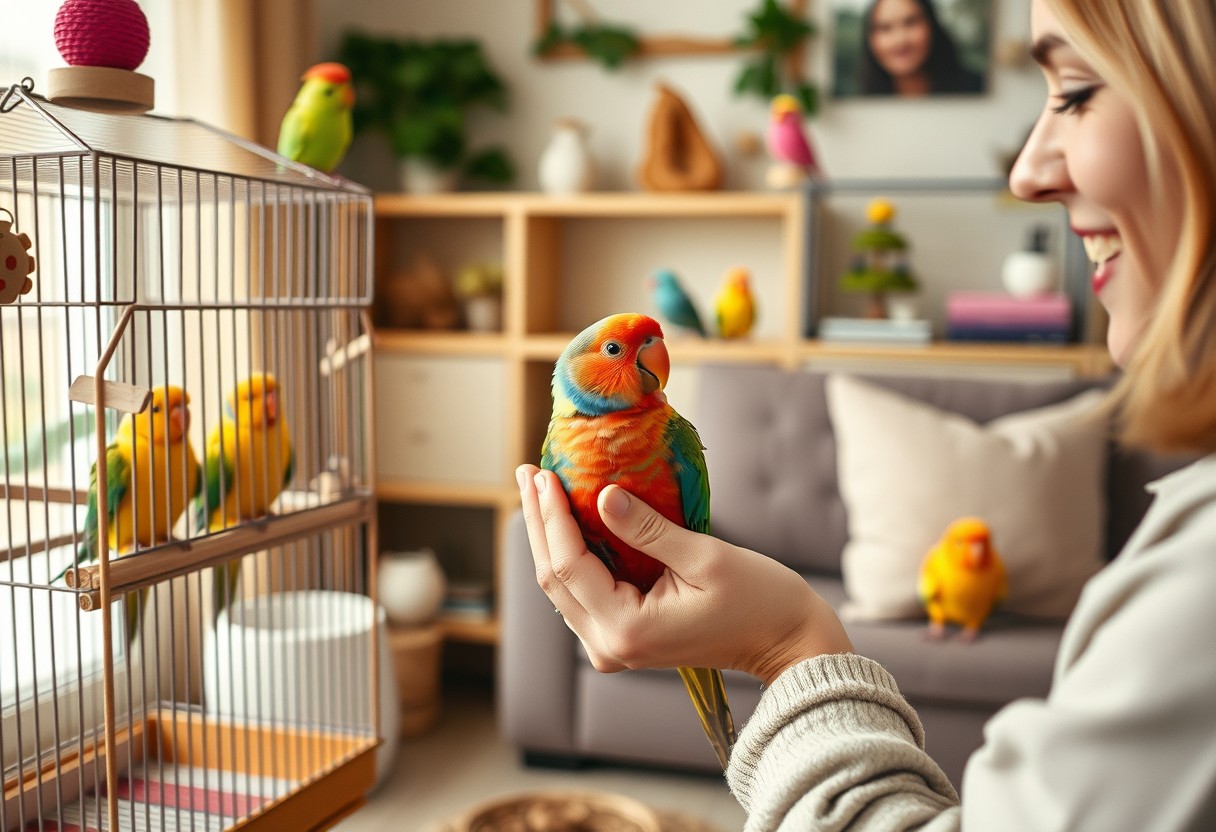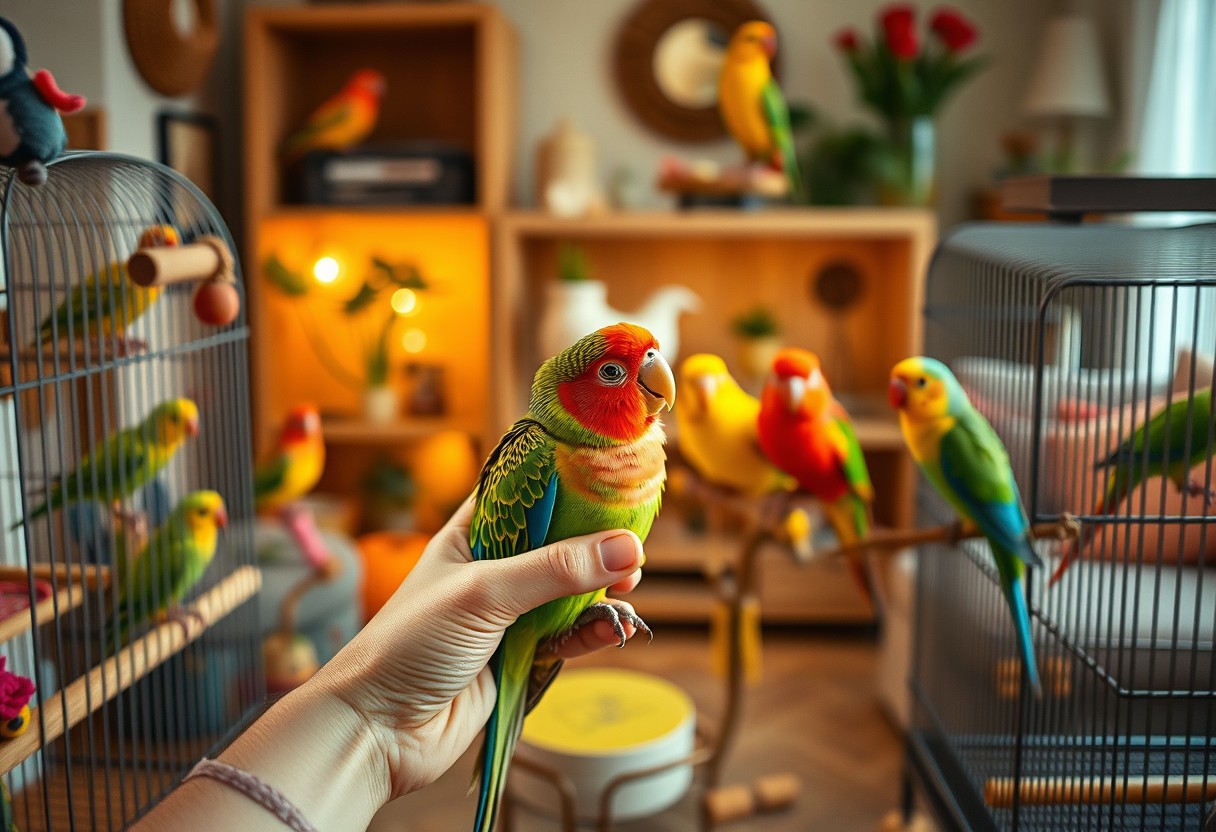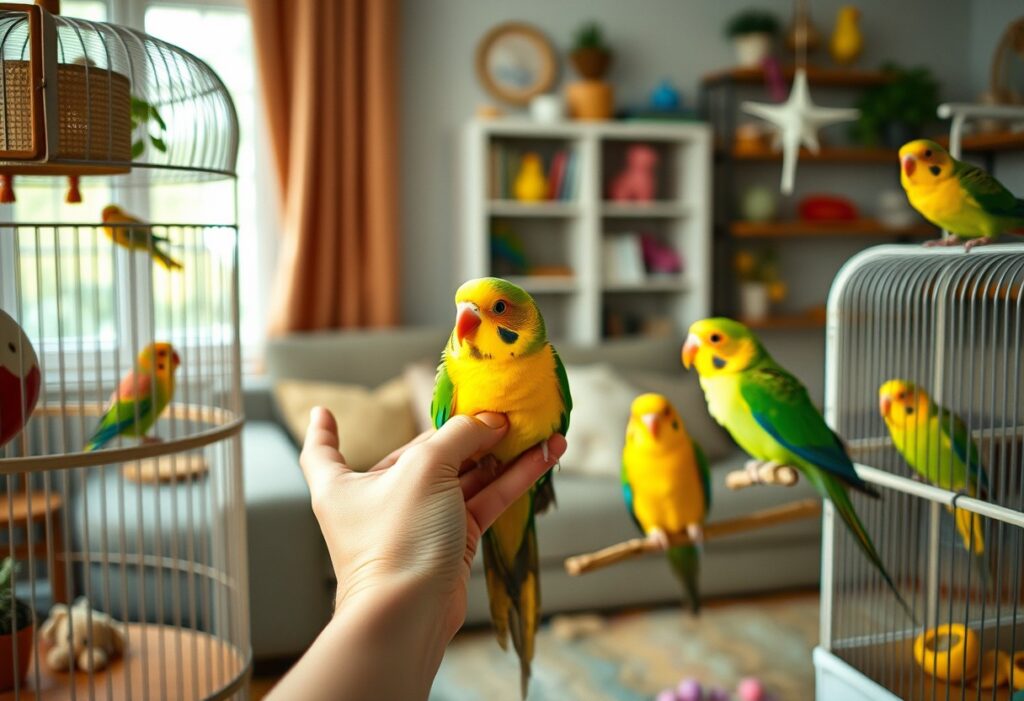Most bird owners experience the excitement of adding a new feathered friend to their home, but introducing a new bird to your flock can be a delicate process that requires careful planning to ensure a harmonious integration. It’s vital to observe quarantine protocols to safeguard your existing birds from potential illness, while gradual introductions can minimize stress and territorial disputes. By following the right steps, you can create a positive environment that fosters friendship and reduces aggression, making your flock a happy and cohesive family unit.


Preparing Your Flock
The preparation of your flock is a crucial step in ensuring a smooth introduction of a new bird into your home. By understanding the current dynamics and providing a safe environment, you set the stage for harmony among your feathered friends.
Assessing Current Flock Dynamics
Any new addition to your flock can disrupt the established hierarchy and social interactions. Before bringing in a new bird, it’s crucial to observe your current flock’s behavior and relationships. Take note of any dominant birds and how they interact with others. Understanding this social structure can help you predict how your birds might react to a newcomer.
Additionally, consider the personalities of your existing birds. Some may be more tolerant or sociable, while others may be territorial or aggressive. By assessing these dynamics, you can determine the best approach for introducing the new bird, minimizing potential conflicts.
Ensuring a Safe Environment
There’s nothing more important than providing a safe environment for both your current flock and the new bird. Start by designating a separate space for the newcomer, equipped with necessary supplies such as food, water, and perches. This prevents immediate face-to-face interactions, allowing the birds to become familiar with each other’s presence gradually.
A good practice is to ensure that all birds have ample space to retreat and hide if needed. Create visual barriers using blankets or cardboard, which can help reduce stress and allow the birds to observe each other without direct contact. Additionally, ensure that the area is free from any potential hazards, such as sharp objects or toxic plants, which could harm your flock during the introduction process. By taking these precautions, you foster a more positive, stress-free environment for your birds as they adjust to one another.
Choosing the Right New Bird
While adding a new bird to your flock can be an exciting venture, it is crucial to consider several factors to ensure a harmonious environment. Choosing the right species will greatly influence how well your new feathered friend adjusts and thrives in your home. Different bird species have unique social needs and temperaments, which can lead to either a smooth integration or a turbulent experience for your existing flock. Before making your choice, engage in thorough research about the species you are considering and how they have interacted with others in the past.
Species Compatibility
While some bird species are known to get along well with others, others can be territorial or aggressive. For instance, parakeets and canaries tend to coexist peacefully, while larger birds like cockatoos may bully smaller species. When choosing a new companion for your flock, it’s beneficial to ensure that the personalities and social structures of the species in question align. Consider factors like vocalization levels, activity styles, and social demands; these elements can significantly affect the dynamic within your flock.
Age and Size Considerations
Choosing a new bird also involves evaluating the age and size of the potential addition. Young birds may be more adaptable and easier to introduce to an existing flock, but it’s crucial to ensure they are mature enough socially and physically to hold their own. In contrast, older birds may already have established habits that could clash with your current flock’s behavior. Additionally, size differences can pose a risk; larger birds may unintentionally harm smaller ones during play or when asserting their dominance.
Understanding the age and size of the bird you wish to integrate is critical to ensuring a peaceful cohabitation. A young, small budgerigar may struggle to fend for itself against a larger, established parrot. Conversely, if you introduce a much larger bird to your small flock, it could pose a danger both physically and socially. Striking the right balance between size and age is crucial for avoiding potential conflicts, helping to ensure a safe and friendly environment for all your birds.

Introducing the New Bird
For every bird owner, introducing a new feathered friend to your existing flock can be a rewarding yet challenging experience. It’s crucial to approach this process with care, as the dynamics of your birds can be profoundly affected by this introduction. Understanding their social structures and behaviors will help you create a harmonious environment for all your pets.
The Quarantine Period
Period of quarantine is a fundamental first step in introducing a new bird to your flock. This period typically lasts for about two to four weeks, during which you keep the new bird isolated from your existing birds. This isolation serves as a protective measure to prevent any potential transmission of diseases or parasites. During this time, you will monitor the new bird for any signs of illness and provide it with ample socialization and attention.
Additionally, the quarantine period allows your new bird to acclimate to its new environment. You should also ensure it has everything it needs—food, water, and comfortable surroundings—while reducing its stress levels. After the quarantine is complete and you have confirmed that your new bird is healthy, you can start planning for the introduction phase.
Gradual Introduction Techniques
Even when it’s time to introduce your new bird to your flock, it’s vital to use gradual introduction techniques to ensure a smooth transition. Begin this process by placing the cages of the birds in the same room, but at a safe distance apart. Allow them to see and hear each other without direct contact. This helps them get accustomed to one another’s presence, reducing the likelihood of aggressive behavior during their first face-to-face meeting.
Techniques you might employ include scheduling short supervised sessions where both your existing birds and the new arrival can interact. Start with just a few minutes a day and gradually increase the time they spend together as they become more comfortable. Ensure that you carefully observe their body language for signs of stress or aggression, and if necessary, separate them immediately to avoid negative interactions. Always reward positive behavior with treats or praise to reinforce friendly introductions.
Monitoring and Adjusting
Once again, the introduction of a new bird to your flock requires ongoing attention and care. After the initial introduction, it’s imperative to monitor the dynamics within your group closely. This involves observing how your existing birds respond to the newcomer and making any necessary adjustments to ensure that everyone gets along. By being proactive, you can prevent potential conflicts and promote a harmonious environment for all your feathered friends.
Observing Interactions
Little changes in behavior can signal how your flock is adjusting to the new addition. Pay close attention to interactions during feeding time, play, and other activities. If your original birds seem to accept the new bird, you may notice them displaying natural behaviors together, such as preening or resting in proximity. However, if you notice signs of aggression, like pecking or chasing, it’s a strong indication that your birds might need more time apart or that the integration process requires a different approach.
Recognizing Signs of Stress
There’s a fine line between normal adjustment behavior and stress-related actions that can adversely affect your birds’ well-being. It’s crucial to keep an eye out for signs such as excessive vocalization, feather plucking, or hiding in corners. If a previously social bird becomes reclusive or starts avoiding interaction, it may indicate that your birds are not yet comfortable with one another. These signs should prompt you to reevaluate how they are introduced and interact.
Monitoring involves maintaining a keen awareness of both your new bird and your existing flock. This means keeping checklists on behaviors that indicate stress, such as reduced appetite or changes in sleeping patterns. If you notice that your new bird is targeted or bullied, or if your established birds become unusually aggressive, you may need to separate them temporarily or rethink the introduction method altogether. By staying vigilant, you can safeguard the health and happiness of all your avian companions.
Final Words
So, as you prepare to introduce a new bird to your flock, remember that patience and observation are key. By taking the time to set up a proper isolation period, monitoring their health, and gradually facilitating interactions, you ensure a smoother transition for both your existing birds and the newcomer. Investing this time will help build a harmonious environment, where all your feathered friends can thrive and feel secure. Keep an eye on their behavior and adjust your approach as needed; each bird has its own personality that may influence how they adapt to new dynamics.
Ultimately, integrating a new bird into your flock can be a rewarding experience that enhances the joy of birdkeeping. By following these guidelines and remaining vigilant, you will foster a space where each bird can coexist peacefully. Your diligence in this process will pay off, providing you with a vibrant and lively aviary for you and your feathered companions to enjoy together.
FAQ
Q: What is the best way to prepare for introducing a new bird to my existing flock?
A: Preparing for the introduction of a new bird involves several steps to ensure a smooth transition. Firstly, designate a separate, quiet space for the new bird where it can acclimate without immediate contact with your existing flock. This separation period should last at least 2 weeks. During this time, monitor the new bird’s health, provide appropriate nutrition, and allow it to become comfortable in its environment. Additionally, it’s advisable to thoroughly clean and sanitize shared cages, toys, and perches to prevent the spread of any potential illnesses. Gradually allow the birds to see each other through a barrier, such as a cage, to help them adjust to each other’s presence. Once they appear calm and curious, you can move on to supervised interactions.
Q: How should I proceed with the actual introduction between the new bird and my existing flock?
A: When you are ready to introduce the new bird, choose a neutral territory where neither bird usually spends time. During the first meeting, supervise closely and be prepared to intervene if any aggression or stress occurs. Keep the introduction sessions short at first (around 10-15 minutes), and gradually increase the duration over time as the birds become accustomed to each other. It’s imperative to observe their body language; signs of aggression, such as flaring feathers or loud vocalizations, may indicate that the introduction is too soon. If initial meetings are tense, try restarting the process after a few days of separation and desensitization.
Q: What are some common signs of stress or aggression I should watch out for during the introduction process?
A: Common signs of stress or aggression in birds include loud vocalizations, rapid beak movements, flaring feathers, and tail feather fluffing. Additionally, a bird that is overly aggressive may attempt to chase or peck at the other bird. On the other hand, signs of stress include excessive preening, hiding, or panting. If you notice these behaviors, it’s important to separate the birds immediately and allow them to cool down before attempting another introduction. Always prioritize a calm and safe environment to reduce anxiety and promote positive interactions. Patience is key; the goal is to develop a harmonious relationship among the flock members.











